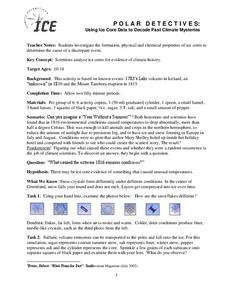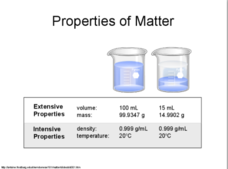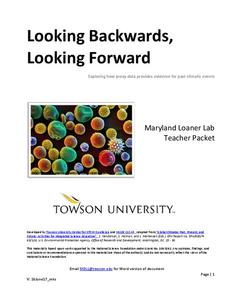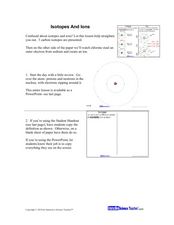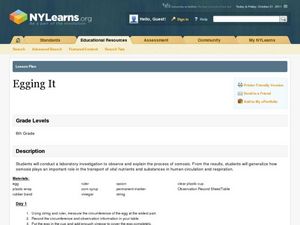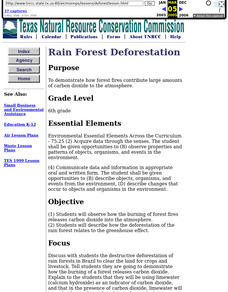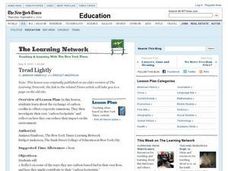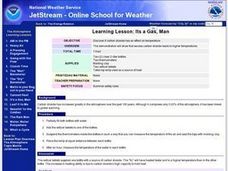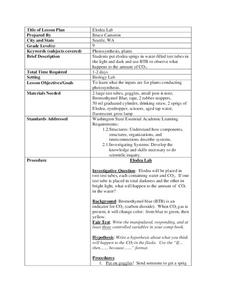Curated OER
Teaching Radioactive Decay: Radioactive Half-life And Dating Techniques
High schoolers generate a radioactive decay table for an imaginary element using a box filled with pinto beans and M&M's. They use their data to plot a decay graph, develop the concept of half-life, and use the graph to "age" several...
Curated OER
Calculating Half-Lives
In this calculating half-lives worksheet, students will use a table with a list of various isotopes and their half-lives to answer 5 problems.
Practical Action
Climate Change - Who's In Control?
How can both individuals and governments respond to climate change and take responsibility to reduce its effects on our environment? Here you will find three lessons filled with discussion, debate, and role-playing...
Virginia Department of Education
Predicting Products and Writing Equations
A chemistry lesson presents 14 chemical reactions for scholars to observe, write the equation, and balance the equations. Additionally, it provides ways to extend the activity as it relates to catalysts.
Polar Trec
Polar Detectives: Using Ice Core Data to Decode Past Climate Mysteries
How does examining an ice core tell us about weather? Learners set up and explore fake ice cores made of sugar, salt, and ash to represent historical snowfall and volcanic eruptions. From their setups, scholars determine what caused the...
Normal Community High School
Density
Change the density of water by adding minerals. The presentation discusses density—from the definition to calculations—and applies it to the real world. It briefly mentions specific gravity, and finishes by showing Archimedes'...
Towson University
Looking Backwards, Looking Forward
How do scientists know what Earth's climate was like millions of years ago? Young environmental scholars discover how researchers used proxy data to determine the conditions present before written record. Grouped pupils gain experience...
Wind Wise Education
What is the Cost of Inefficiency?
What does it cost to keep the lights on? Through a hands-on activity, class members use a watt meter and determine the amount of energy different types of light bulbs use. The class then determines the financial and environmental...
NASA
Global Air Temperatures Graph: Student Activity
Analyze years of hard climate change evidence in minutes. Climatologists evaluate graphical data about climate change by answering questions. Scientists work collaboratively using a literacy cube or virtual die that directs them through...
Curated OER
Isotopes and Ions
Students examine the concepts of isotopes and atoms. In this powerpoint lesson, students see the balance in numbers of protons, neutrons, and electrons create isotopes and ions of certain atoms.
Curated OER
Diving Raisins
Learners hypothesize and observe what occurs when raisins are dropped in a carbonated liquid. They examine buoyancy and how density effects ascent and descent.
Curated OER
"The Yeast of Our Worries"
Students study yeasts or cellular respiration in this inquiry activity. They examine different types of bread to show which rise or do not. They measure the amount of carbon dioxide released by the yeasts when using different sweeteners.
Curated OER
Stoichiometry
In this chemistry worksheet, learners solve various problems on stoichiometry by following what each statement describes. They identify how many moles and grams of carbon dioxide will be produced and what the theoretical yield in moles...
Curated OER
Photosynthesis and Respiration
In this photosynthesis and respiration worksheet, students will explore the function of the stomata on plant leaves Students will write the photosynthesis equation and label a diagram showing the movement of water, carbon dioxide, and...
Curated OER
Nutrition and Energy Flow
In this energy flow worksheet, learners will complete 10 short answer questions based on a food web diagram. Then students will review different cycles in nature including the water cycle, carbon cycle, and energy cycle. This worksheet...
Curated OER
Egging It
Sixth graders discover scientific processes by conducting an experiment in class. In this osmosis instructional activity, 6th graders utilize eggs, cooking ingredients, string and plastic cups to create an experiment in which they watch...
Curated OER
Respiration and Gas Exchange
In this body systems worksheet, students complete a word equation for respiration. Students draw and label the human respiratory system. Students draw a diagram of the movement of oxygen and carbon dioxide in the air sacs.
Wind Wise Education
Understanding Electric Power Generation
You mean the electricity does not come from the switch? As a class and in small groups, learners explore the sources of energy used to generate electric power. Worksheets guide groups into choosing a future electricity generating...
Curated OER
Environmental Hazards
Students identify environmental hazards on a simulated field trip. They analyze the exposure and suggest methods to eliminate or reduce exposure to toxic sources.
Curated OER
Nuclear Fleas
Seventh graders distinguish characteristics of living things and identify the importance of careful observation. They identify five things that are not alive, but display characteristics of life and list five things that are alive, but...
Curated OER
Rain Forest Deforestation
Sixth graders explore the destructive deforestation of rain forests in Brazil to clear the land for crops and livestock. Students demonstrate how the burning of a forest releases carbon dioxide by performing an experiment.
Curated OER
Tread Lightly
Students investigate the use of carbon fuels and how they effect the environment. They conduct research using a variety of resources. The information is used from the reading to calculate one's personal influence upon the environment.
Curated OER
Learning Lesson: Its a Gas, Man
Students participate in a demonstration in which they examine the effect on temperature by carbon dioxide. They discuss the effects of carbon dioxide on the environment. They also examine summer safety rules to end the lesson.
Curated OER
Elodea Lab
Students observe the changes between elodea leaves placed in darkness and light. In this life science lesson, students experiment to find evidence of photosynthesis in elodea leaves. Students use indicators to detect the presences...




